The Greatest Nose artist of WWII

Part One
Introduction by Clarence Simonsen
I have collected, researched, and repainted replica World War Two “Nose Art” for the past 45 years, including meeting and interviewing some thirty [documented 93] of these special aviation illustrators. An illustrator is defined as an artist who specializes in providing a visual art form which corresponds with the content of an associated text or idea. Thousands of years ago, early illustrator artists were commissioned to paint portraits of the most important people in history, kings, Aztec gods, nobles, pharaohs, and the wealthy important males and his family in that period of time. Sometimes the wealthy male would also commission an illustrator to paint his mistress in the nude, which the Prime Minister of Spain did in 1792. P.M. Manuel de Godoy had his own private collection of female nudes [like Pin-Ups] which were hidden from the public and of course his wife. These two most famous and controversial paintings were both life-size, the same model, but one with clothing and one completely nude. The reason for the twin images, virtually identical other than one is fully nude, is still unknown. Painted by Francisco de Goya, it is believed the young lady was the mistress of P.M. Godoy, Pepita de Tudo, and her age was 14 to 18 years, when she modelled for many hours of detailed brushwork to complete both images.

The world-famous, priceless, “La maja Denuda” painted between 1793 and 1797 by fine artist Francisco de Goya, and not judged as obscene art. This ‘fine art’ painting has been reproduced and marketed countless times and today is displayed for millions of visitors to see in Spain. This became the first female nude painted in the Western world to show pubic hair, and for that reason was banned by the United States for a period of time. This famous fine artist painted the young lady as she looked for the time period, a great Spanish realist tradition, even if she was underage by today’s standard. During my fifty years of nose art research and painting, it became very clear the most popular theme for both the fine artist and the art illustrator was the young female form, fully nude, semi-nude, or topless. For some reason the bureaucratic mindset of the fine art world began creating a division between the art illustrator and the fine artist, which I still do not fully understand. To my way of thinking, some artists were just much better than others in creating an appealing image of a pretty young girl or women, and they should never be separated by any high society class system.
The later 1920s nude girl artists were classified as illustrators or commercial artists, while it is clear many shared the same skill [or more] than the fine artist. These male and female artist illustrators would create the world of the Pin-Up girl in the Golden Age from 1920 to 1965, but today this nude art is not suitable for family viewing, however “fine art” nudes are permitted. What am I missing in this special created high-art-world where one nude is Ok, but the other is not good for children to look at?
Pin-up art began as early as 1890, [maybe even earlier] and many artists participated in the popular culture, which became associated with the soldiers in WWI who carried the images of beautiful women taken from calendars, magazines, and post cards. These paintings, and drawings, which featured glamour girls, models, and actresses, would not change very much until the early 1930s when the mastery of the airbrush was invented and introduced by artist George Petty. The early appearances of Petty male and female art were restricted to near-beer advertising in local circulation of the Midwest United States.
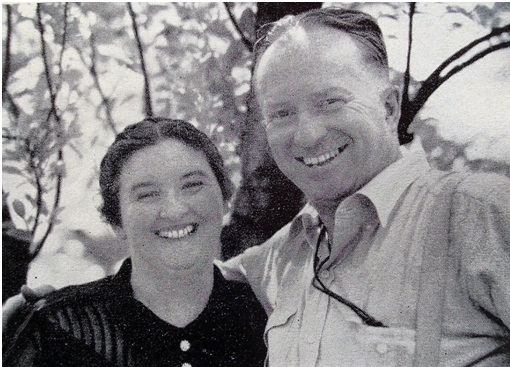
George Brown Petty IV, was born 27 April 1894, showed a keen interest in drawing, and was always in trouble with his teachers for sketching during class. He enrolled in evening classes at Chicago’s Art Institute where he developed a business sense, offering other students art instruction for five bucks a lesson. On summer vacations, he spent hours in his father’s photo shop where he learned the skills to operate the airbrush, which was used extensively to retouch the large black and white 4” by 5” negatives. Fascinated with the instrument, he became proficient at creating paintings using the fine spray in building colors layer upon layer. His human face and skin tones produced a new radical life-like rendering of beautiful girls and women which became extremely popular. He next met a shy, pretty, modest young lady Julia Donohue, courted her, and they married on 6 April 1918. Julia became his chief nude model for the next ten years. The above image of Julia and George was taken by LIFE magazine in 1939, appearing in the June issue.
On 21 September 1919, the first child was born, Marjorie Julia Petty, with a nickname of “Mugs.” This new baby girl would change the world of the pin-up women forever.

Twenty-year-old Marjorie Petty as she appeared in LIFE magazine June 1939.
In 1929, the United States was stuck in the great depression, facing economic collapse, while George Petty fortunes began to slowly raise. George had been hired to design a poster point-of-sale display for the Lesser’s Slim Figure Bath, a German bath salt which would simply soak away those unwanted female pounds. While the product was in fact useless, the American ladies believed it worked, and they purchased the salt bath product, which made money. The original Berlin bath salt container art featured two young nude German ladies dancing, and this must be included in the new rush job contract. Marjorie had posted semi-nude many times for her father but she always walked around in a towel. This time George grabbed the towel and threw it to his wife Julia. He then stood Marjorie in front of his drawing board, and for the first time she posted fully nude. This was where the “Petty Girl” was born and Marjorie was only ten years of age. This should not be confused with today’s child pornographic images, it was simply a family enterprise in 1929, where Marge spent long hours holding a pose for her father to sketch. She was the living family created Petty Girl.


The first 1929 poster art posed nude by [underage] ten-year-old Marjorie, but painted as a twenty something lady.
With the launch of a new magazine “Esquire” in fall of 1933, the new Petty Girl appeared in a conventional cartoon format, which soon developed a national reputation as a near-nude pin-up girl.

Marjorie was fourteen when she posted nude for this first issue of Esquire cartoon painting. The caption read –
“Darling, what —-kachoo—-difference does age—–kachoo—–make anyway?”
As her pin-up popularity grew, George Petty dispensed with the secondary characters, who were mostly older rich gents. This was the time of the great depression, when pretty young girls were drawn to the rich older high society males who still had money. She was most often painted holding a telephone, which was left white and never sprayed, becoming a George Petty future trade-mark.
The Petty girl soon appeared in ads for cigarettes, bathing suits, silk stockings, underwear, and graduated to full pin-up status in magazines. Beginning in 1939, the Esquire readers were treated to a monthly two-page foldout [gatefold] of the Petty Girl. As the world went to war, [American remained neutral] but Canadians took the Petty Girl to England and she became a major aircraft nose art attraction. [below is a 1938 full-page ad from inside front cover of Esquire magazine]


In 1981, I received the above letter from Mr. Reid Stewart Austin, during his research on the George Petty story. Reid was the art director of Playboy magazine in the 1960s and left to become the personal art director of Alberto Vargas, where he remained until 1974. With the cooperation of Marjorie Petty and the Petty Estate, he authored the book “Petty” in 1997. We never met, but he assisted me by proof-reading my articles, sending Petty Girl art, photos, and talking for hours on the phone. I would like to express my special thanks to Reid Austin for taking time his time to relate to me the wonderful life of George Petty and the one and only Petty Girl, Marjorie. I expressed to him my admiration for the Petty Girl and wondered if it would be possible to obtain her autograph.

This signed portrait of fifteen-year-old Marjorie arrived by mail on 29 June 1996. She appeared on the cover of the Chicago American, The Saturday Home Magazine, 19 October 1935. She had been modelling nude for the past five years, and continued to do so until she married in 1948. She also assisted in preparing each painting, working in the studio, making preliminary sketches, and without Marjorie there would be no “Petty Girl” as we know today.

If you want to read the complete history, Reid Stewart Austin’s book is the one and only.

Twenty-nine-year-old Marjorie Petty in her last calendar of 1948.

From 1933 to 1956 the Petty girl became an American icon which captured the nation’s admiration and more importantly allowed the pin-up girl into the average American and Canadian household wall. He was a freelance art illustrator, but his airbrush combined with the paint brush changed the way the world saw the Petty Girl. He mastered a new art form and his fine paint spray created from light tones to darker shadows giving the viewer a realist three-dimension female form. He improved the female body with longer legs, a small long torso, and a smaller head. By 1939, they said he created a lady better than God. In 1941, he was working without a contract and making $2,000 per pin-up painting, plus demanding more. Esquire went looking for a replacement and found Alberto Vargas. The last Petty Girl appeared in Esquire as American went to war, but George had left a rich legacy in the glamour girl art, which had been passed on to the aviation nose art in WWII.
During the Second World War, there were hundreds of artists and illustrators who painted for periodicals, calendars, etc., but only 45 to 50 were exclusively painting glamour girls or pin-up art. Practically all of these “illustrators” had been rigorously trained and graduated from the same high-class art schools as their colleagues in the “fine” art category. They had mastered the fine art of painting a glamour pin-up girl or women but their art quality was never allowed to be shown in a gallery, museum, or history book for the simple reason they painted young topless or nude females.
In 1971, the master of the female form, George Petty was asked why the pin-up calendar was no longer being printed and had almost disappeared. George stated –
“Everything today must be shared with one’s wife and children, so a man can no longer have privacy for his girl calendar.”
There is more truth to his statement then one could ever imagine.
Although George Petty and Alberto Vargas achieved all the fame and public attention during World War Two, another artist set the standard for the most respected glamour pin-up painting.

Gil Elvgren was born 15 March 1914, took summer art classes at the Minneapolis Art Institute beginning in 1924 and continued with day and night art classes at the American Academy of Art, Chicago, graduating in 1936. He was very well-trained, a master with a rich painting technique, which met all the tradition standards of fine art, but his genius talent was viewed with prejudice only because he painted pin-up illustrations. The Elvgren Girl was a fresh and wholesome young lady, with a slender body, which personified the American “Girl-next-door.”
Forced Landing was one of his early paintings which measured 22” by 28 “painted in oils on canvas, possibly completed in 1935. This is a calendar reproduction which was also republished as a “Mutoscope card” in 1939 or 1940, which was an ‘overpainted’ style. Another artist [Vaughn Bass] would overpaint the original Elvgren background but never repainted the face, legs, arms, or other body parts of the original. This was all done to avoid paying copyright fees or other legal issues, and that is why the signature of Elvgren appears in block lettering. This image appeared on a number of WWII aircraft and was a nose art favorite pose.
For his commercial paintings, he completed one lady per week, working from photographs taken of his posed model. An assistant [Ewen Lotten] would build a studio set and Elvgren would take a half-dozen photos of his model in different positions, which would later become his new oil creation. Today the Internet is full of these images and his favorite model Marlene Reilly who was twenty years of age. Elvgren liked models with long necks, long slender legs, small waist and a full bust, but not too large. His perfect face was that of a fifteen-year-old and the body of a twenty-year old, eyes set wide apart, small ears, pert nose, and smooth legs and hands.

The left [above] image is another 1940 Mutoscope card reproduction, which was over-painted by artist Vaughn Bass, who created a key-hole style, as if a male were watching a young lady get undressed. This simple overpainting of the original Elvgren painting became a huge hit with WWII aircrew and appeared on hundreds of aircraft.
Few of his commissioned works were painted with topless or nude models, however to relax and for his own personal pleasure, he liked to paint beautiful women in the altogether. I have five in my collection, nude in chair with fur, oriental full nude, nude on bed putting on makeup, nude on a river bank, and a nude on a calendar from Singapore.

This painting was titled “Fascination” and appeared on a calendar of the Amoy Canning Corporation [Singapore] Ltd. date unknown. It was found in a suitcase that belonged to a deceased RCAF pilot and his sister gave it to me in the late 1980s.
Gil Elvgren passed away at age 65 years, after he lost his battle with cancer, 29 February 1980. His paintings of beautiful women will live on forever.
Other illustration artists switched to pin-ups to make more money, such as Saturday Evening Post cover artist Robert Edmond Lee, 1899 to 1980. He painted this monthly full-page pin-up series titled “Cuddles and Puddles” which again found its way to a number of nose art paintings in England. He sold his series to magazines such as LOOK and PEP.

In 1941, the first Zoe Mozert nude pin-ups began to appear in Brown and Bigelow calendars, and they were also published in the Mutoscope cards series called “Victory Girls.”

They were a huge hit with the servicemen in WWII, yet very few males at war knew they were painted by a lady just as good-looking as her nude artwork. The truth being, Mozert often used herself as a model and posed in front of a mirror, such as the above full nude glamour painting. Born in 1907, in Colorado Springs, Colorado, as Alice Moser, she changed her name as she would never become famous with a name like Alice. She entered the Philadelphia School of Industrial Art where she helped pay her tuition by nude modeling for art classes in nearby Women’s School of Design. In 1946, she moved to Hollywood, worked as a consultant in films, painted film posters, created over 400 covers for movie magazines, and her nude calendars paid the biggest accounts for Brown and Bigelow. She died in Arizona 1 February 1993. Zoe was very proud of her body and it is insane we do not consider her talent [and body] to be fine art.
This 1941 painting “A Run on Sugar” appeared in the Mustoscope card series “Victory Girls” and the suggestive pose appeared on a number of WWII aircraft.

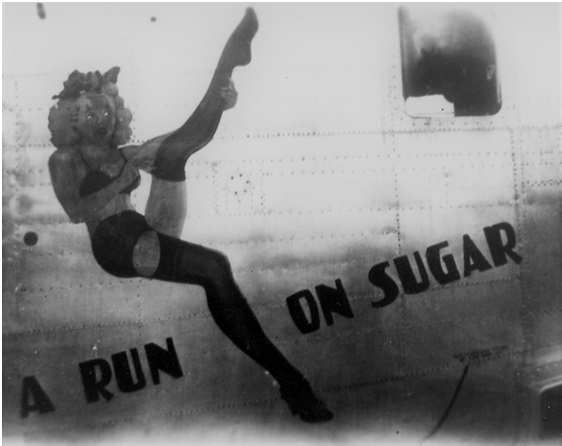
This 8th A.F. B-24 bomber crew carried “A Run on Sugar” over Germany.
Four other women artists painted glamour pin-ups, the Patterson sisters, Laurette and Irene, who worked with pastels, and Pearl Frush another pastel artist.

Above is the 1942 calendar by Mabel Rollins Harris, who painted in the style of Alberto Vargas, and has been judged as an equal, in her artistic excellence of painting the nude.
To this point, I have attempted to show a selected few samples of the great illustrators of the twentieth century, they were the masters of painting the glamour pin-up, and I believe they should be given the same level of respect as their colleagues in the fine art world. During the Second World War these illustrators created tens of thousands of paintings which generated a spin-off art form known as aircraft ‘nose art.’ Beginning in early September 1939, Canadians and Americans both joined the Royal Air Force and the Royal Canadian Air Force and after training most arrived in England, and with them came the art of the George Petty Girl, followed by the art of Alberto Vargas in January 1942. American historians and WWII publications tend to forget the early 1939, 1940, and 1941 Petty Girl pin-up images were appearing as nose art on British and American aircraft flown in England and training in Canada, two years before the attack on Pearl Harbour, 7 December 1941.

This image was taken by LAC Lloyd Carbert, ground crew RCAF No. 2 Elementary Flying Training School, Fort William, Ontario, [today named Thunder Bay].
The RCAF training school opened on 24 June 1940, and D.H. 82C, Tiger Moth serial 5028 was delivered to the base on 19 June 1940, and taken on strength. This trainer aircraft [assigned letter “A”] graduated hundreds of future pilots in the British Commonwealth Air Training Plan, until 16 June 1945, when it was struck off charge and sold for scrap. The March 1941, Esquire Petty girl was titled Bashful, with caption –
“No. it isn’t that I have anything else on, Mrs. Van Gilder…. but I didn’t know it was to be a come-as-you-are-party.”
This image was painted on the black nose of the RCAF yellow fuselage painted trainer with name – ‘DADDY’S CHOICE.’ The Canadian artist had talent in both lettering design and painting of the nude female, yet he has been totally forgotten by history, due to the fact he painted “Petty Girl” pin-up art on WWII aircraft. Why can’t today’s aviation museum’s display this image from the past? It was not obscene or offensive in March 1941, when it appeared in over 300,000 issues of Esquire, read in both United States and Canada.


These two George Petty prints were sent to me on 26 October 1981, by Reid Austin. They are from the Reid Austin Collection of American Graphics and show the brilliant business mind of George Petty. The original painting of “Bashful” [left] appeared as a two page ‘gate-fold’ in Esquire for March 1941. The first Varga Girl appeared in Esquire in October 1940, and George knew they were soon replacing his Petty Girl [and him] at some future point. He took this original art painting, reversed the image, painted on a pair of pink panties and created the “PETTY PANTY.” This not only made more money for George but his pin-up girl continued to be printed in magazines during the American WWII years 1942-1945. I feel the twelve Petty Girl paintings completed in 1941, were the very best of his work, and the almost full nude look made them the favorite pin-up girl and aircraft nose art painting. As America went to war, the Petty Girl painted on the nose of many aircraft joined the battle.
In September 1940, Esquire ran the first ad announcing a new “Varga Girl” would be unveiled in the October issue, and the first twelve-page Varga Girl calendar appeared in the December 1940 issue. In June 1941, the owners of Esquire introduced the first Varga Girl playing cards, which was based on the original George Petty idea. This was a direct slap in the face to George Petty, and he was not only angry, but also deeply hurt. The final Petty Girl promotion was a small book called “Book of Petty Phone Numbers” containing thirteen new unpublished girls. Maybe the Esquire owners picked the “13” girls for a special reason.
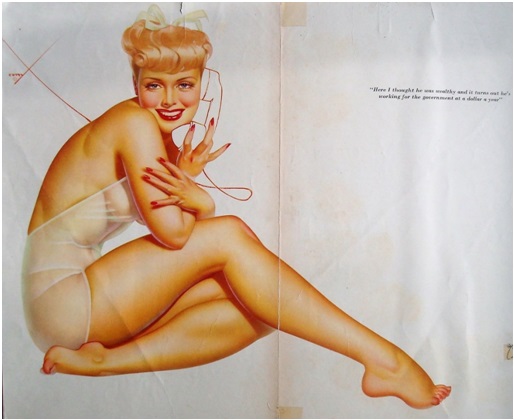
This was the very last Petty Girl gatefold to appear in the December 1941 issue of Esquire. George Petty continued to produce paintings for Old Gold cigarettes, Jantzen bathing suits and Pepsi-Cola soft drinks. In November 1941, Marjorie and Julia took a five-week vacation in Hawaii. They sailed for San Francisco on the morning of 5 December, leaving Honolulu on the ship Lurline, arriving in San Francisco on 12 December 1941. The United States had declared war on Japan, and now all of the past Petty Girl images would be painted as aircraft ‘nose art.’

The first advance parties of the American Eighth Air Force H.Q., Bomber, Fighter, and Base Commands arrived at Liverpool, England, on 11 May 1942. This was the beginning of the Mighty Eighth Air Force, which first had to adopt certain British systems and proven war procedures which involved camouflage and code letter painting of their bombers. On 1 July 1942, the first combat USAAF B-17E, 41-9085 of the 97th Bomb Group touched down at Prestwick, Scotland. Thousands of American aircraft would soon follow and the nose art on the Eight’s B-17 and B-24 bombers was famous. In 1942 and 1943, an 8th Air Force bomber crew were assigned and retained [when ever possible] their own aircraft, and it became common practice to paint their individual names near their combat station. When I interviewed the famous nose artist Tony Starcer in 1979, he recalled that crew names were the very first B-17 painting he completed at Kimbolton, England. While the bomber was U. S. government property the aircrew considered it to be ‘their plane’ and that led to a nose name or painted image. Their favourite decoration became the female form and the main inspiration came from “Esquire magazine” pin-ups, plus the many other great illustrators back in the United States.

1st. Lt. Delmire B. Brown, bombardier in B-17G, 42-3524, “Vonnie Gal” 379th Bomb Group, 527th bomb Sqn. and his bunk in a Quonset Hut at Kimbolton, England, 1944. He reads the June issue of Esquire magazine, above his head are two photos of his baby daughter, and the other wall contains five Varga pin-up girls, left to right – May 1944, September 1944, March 1944, and January 1944. The far right bottom is August 1944. The 91st B.G. had been at Kimbolton until 17 October 1942, then the 379th moved in on 20 May 1943.


The second Varga Girl appearance in Esquire – November 1940.
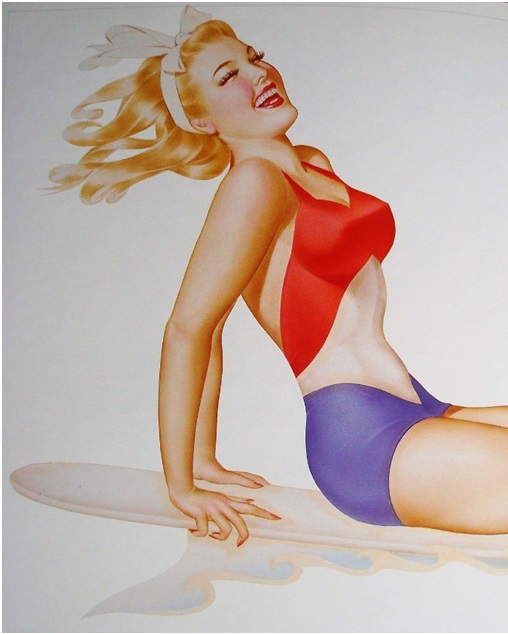
It is important to understand the “Varga” and “Petty Girls” were never painted nude.

It was the combat nose artist who painted the girl topless or nude. Above is the August 1944; Varga Girl in Esquire magazine, and below she is being painted topless somewhere in the Pacific.

The September 1944 Varga Pin-up Girl from Esquire, only appeared nude on aircraft.
The best American artist at each base in England was now selected to decorate the front [nose] of the bombers and many paintings were of a very high standard. The new pin-up girls painted by Alberto Vargas were the favourite and the only girl now appearing in Esquire magazine, however the lasting power of the original Petty Girl remained throughout the war. The reason for this was simple, the young American aircrew and Allies such as Canadians, had grown up with the Petty Girl pinned on their bedroom wall, beginning in 1933. The Petty Girls from 1933 to 1939 suddenly began to appear as bomber nose art in England, they had been taken to England by many American aircrews.


The most famous 8th A. F. original Flying Fortress in the world is “Memphis Belle” B-17F, 41-24485, painted by Cpl. Tony Starcer, [above in 1943] and she was the April 1941 Esquire Petty Girl. This was the third American Flying Fortress Tony painted in the 91st Bomb Group, and Starcer would paint at least 108 more, but his exact nose art total is not known. The B-17 pilot Morgan wrote to Esquire magazine asking for a pin-up to go with his girlfriend’s name, and George Petty mailed him the April 1941 gatefold which showed no face. Twenty-five missions later history had been recorded.

The most famous 8th Air Force Flying Fortress nose art in the world and the face of Marjorie Petty is not shown.

This image was taken by Dr. Harry Friedman, Board of Directors, Memphis Belle Memorial Association, Inc., during the first major restoration beginning in 1982. I had requested an image of the original Petty Girl painted by Tony Starcer in England in 1942. In a few minutes, she was removed forever. The port nose contained a blue bathing suit of the April Petty Girl.

My invitation ticket to the unveiling of Memphis Belle at Mud Island, Mississippi River, in 1987.

Today you can watch online the Kodak color combat camera film of the Memphis Belle, which also contains the nose art of Tony Starcer, all recorded on 16 mm Kodachrome film.

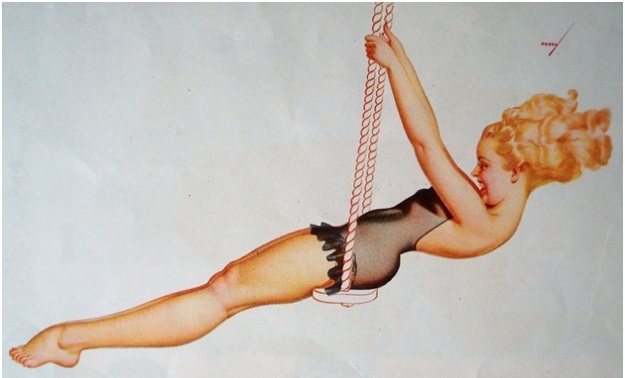
In 1939, George Petty was being paid $1,850 per month for each Esquire Petty Girl painting. He also had contracts for two other paintings per month and made 4 to 6 thousand every four weeks. George retained complete ownership and copyright for each of his paintings and thus he was able to resell all his original series gatefolds again and again. For some girls he just repainted over full nudes with a see-through garment and resold the painting. Millions of Petty Girls appeared on drinking glasses, and art prints sold directly from the home of the Petty family business.


These half page ads appeared in LOOK, LIFE, and other family magazines during the war, and it is very easy to see why the Petty Girl remained a major aviation ‘nose art’ subject until 1956. It is also easy to understand how George Petty became a multi-millionaire during the dirty 30s, when nobody had a job or money. The Old Gold Cigarette ad appeared in LIFE 1939, and original painting had dark blue top. It is believed Old Gold paid $800 to $900 per Petty Girl. Today this original is worth $20,000 or more.

George Petty began his revolutionary resale and repainting practice in 1937, and wisely recognized the power of the Petty Girl and her reproduction rights. This not only saved him time and made more money, it allowed him to resell the Petty Girl image to clients who could not afford an original painting. The full color page [10” by 14”] on the left appeared on the inside cover of Esquire magazine for May 1939, for which Petty received $900 from Old Gold. That issue already contained one Petty Girl pin-up which Esquire paid George $1,850 and the black and red image appeared in LIFE magazine as a half page for $500. George made $3,250 for “one-time” use of two girls and we have not counted the money he made from Pontiac, Jantzen, Gobelin Chocolates, and others in just one month. The 1939, Petty Girl was all over the place and that coming September, the world [other than the United States] went to war. Today it’s simply how one person perceives the airbrush art of George Petty and how they wish to interpret the women designed better than god, but never painted in the nude.
Today you can still find auctions of original George Petty pin-up art, however the price range is $20,000 to $50,000.
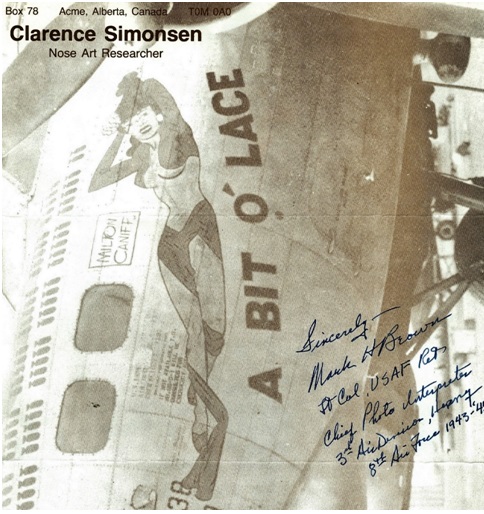
In 1941, the Kodak Company, Rochester New York, had developed a new Kodachrome 35 mm slide film, but it was expensive and not in supply for the general public due to the war effort. This new film had a very low ASA and produced a very rich dark color if not exposed properly. Col. Mark H. Brown was a 3rd Air Division, 8th Air Force, Chief Photo Interpreter of the U. S. Strategic Bombing Survey and his unit was supplied with Kodachrome 35 mm slide film. Col. Brown was also an expert in the use of the 35 mm camera and how to set the correct time exposure for this new color slide film. He would walk around the airfields of the 8th Air Force in England and take images of all the operations involved with running an airfield during wartime. By May 1945, he had captured some 1,200 color images of the Mighty Eighth Air Force in England, then took them home to the United States and they were forgotten. In 1981, I was editing my own ‘nose art’ column in the newly created 8th A. F. Historical Society Journal monthly publication. Lt. Col. Brown sent me a letter asking if I would be interested in a copy of his 35 mm slide film which contained a number of B-17 and B-24 nose art images. I wanted anything connected with nose art and the original slides were mailed to the Kodak company in New York, were duplicates were made and returned to me for $2 per slide. I did not know what to expect, but now I will share some of my excitement with readers. This complete collection was donated to the 8th Air Force Historical Society when Lt. Col. Brown passed away, and I believe it can be purchased online today. I’m sure the price will be a little bit more than what I paid back in 1982.

Mark Brown captured this stunning B-17G nose art by Sergeant Jay Cowan of the 490th Bomb Group.

This glamour nose artist cleverly painted the two letters “B” as part of the female anatomy.

These four beautiful images were taken at an 8th Air Force modification base in England, July 1944. The German fighters are beginning to attack the American B-24 bombers from the side, attempting to wound or kill the pilot and co-pilot and this new pilot protective armour has just been added to the bombers. This protection covered up some of the impressive artistic impressions which would not be seen again until the war ended in May 45. By 1947, thousands of American aircraft had been chopped up and smelted along with their impressive nose art images from the soon forgotten war. The nose art illustrators returned to civilian life and while some made a very good living from art, others such as Tony Starcer never painted again until his retirement years. The Golden age of aviation nose art ladies just disappeared, and the world of photography took control.

The Daguerreotype camera was invented by Louis Daguerre in 1837, and George Eastman released the first Kodak camera in 1888. By 1935, the nude photograph was slowly replacing the artist-rendered pin-up girl and by 1960, the painted girl calendar was phased out of production. By 1965, almost all calendar publishers were using fashion and photographers for all their pin-ups. The topless photos in Playboy would soon turn to full nudes and the Internet would destroy the painted world of the pin-up forever. It was not until 1982, when I viewed the large collection from Mark Brown, I realized for the first time the 35 mm camera and Kodak color slide film had in fact saved a small selection of the 8th Air Force nose art creations from England in 1944.
Among the vast collection of slides were seven which recorded and saved in brilliant color the paintings of one very talented nose artist, Philip S. Brinkman of the 486th Bomb Group, England.

To be continued with Part Two – The Forgotten Phil Brinkman History.
The history of this art work is amazing. It’s a real shame so much if it was lost forever!
LikeLiked by 1 person
More to come…
LikeLiked by 1 person
I have seen the Vargas playing cards that have a biography of him on one of the inserts which say he received the Order of the Sun award from Peru and a citation for meritorious service from the US Government. Can you tell me if these are true statements, as I cannot find any official confirmation thereof.
LikeLike
I have no information on this.
LikeLike